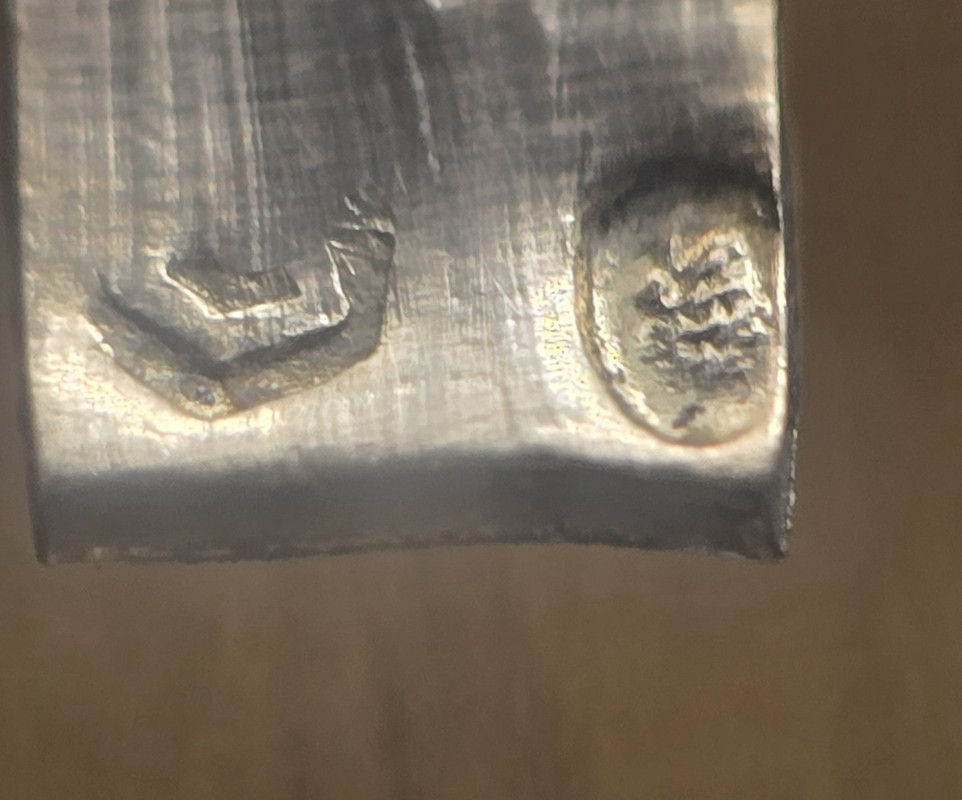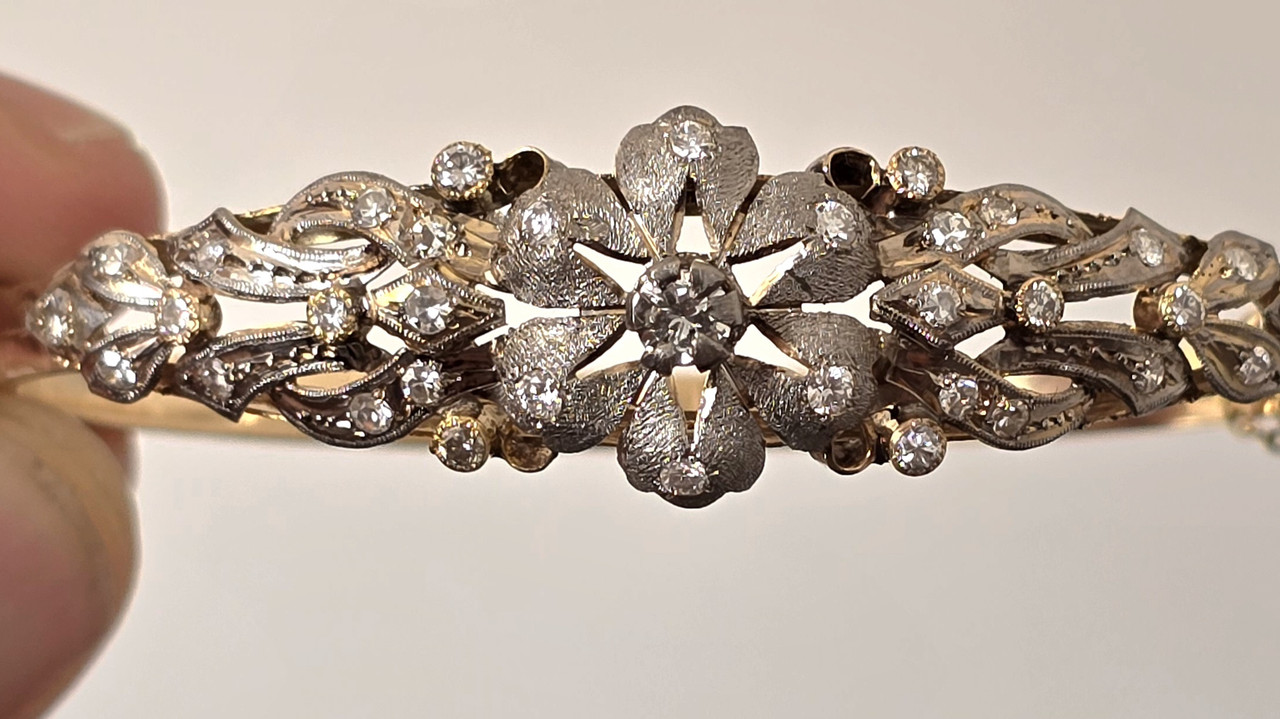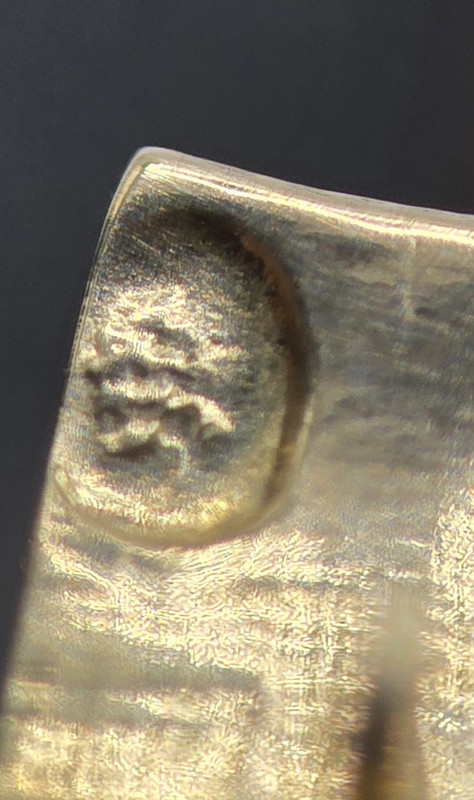
Help me identify this mark
Re: Help me identify this mark
:::: I keep seeing the faint outline of a female(?) head staring directly towards me in the left-side of this oval. ::::

::::: Is this hallmark really a bird? :::::::::: I keep wondering if this could be 19th century Italian, in which all the separate city-states had separate silver hallmarks, I am assuming they all had separate gold hallmarks as well, but I keep trying to figure this out, it's difficult. :::::::

::::: Is this hallmark really a bird? :::::::::: I keep wondering if this could be 19th century Italian, in which all the separate city-states had separate silver hallmarks, I am assuming they all had separate gold hallmarks as well, but I keep trying to figure this out, it's difficult. :::::::
Re: Help me identify this mark
::::: Is it possible the oval hallmark is a Russian gold hallmark that has been intentionally obliterated? ::::::::




-
cosmin.stiop
- Posts: 32
- Joined: Sun Mar 03, 2024 3:38 pm
Re: Help me identify this mark
Thank you for your remarks! The bracelet is not that old. I assume it's Art Deco period, somewhere between 1920-1940 since it has brilliant cut diamonds. I struggled to find similar mark but with no luck. It can be anything. To me somtimes it looks like an eagle head with chest, sometimes I find a turkey.
-
cosmin.stiop
- Posts: 32
- Joined: Sun Mar 03, 2024 3:38 pm
Re: Help me identify this mark
:::: It still could be 1903-1917 :::::: I don't see why it has to be Art Deco, specifically post-1920, but maybe I'm missing something. :::::::::
::: Someone may have intentionally obliterated the hallmarks, and that could be an obliterated head that is seen on Russian Gold, but I can't tell anything for sure yet, maybe someone will know something about that other hallmark. ::::::::::::::::::::
::: Someone may have intentionally obliterated the hallmarks, and that could be an obliterated head that is seen on Russian Gold, but I can't tell anything for sure yet, maybe someone will know something about that other hallmark. ::::::::::::::::::::
-
cosmin.stiop
- Posts: 32
- Joined: Sun Mar 03, 2024 3:38 pm
Re: Help me identify this mark
I would say it's post 1920 because brilliant cut was invented in 1919. It could be older just in case the old cut diamonds on it where replaced post 1920 but I don't think it's the case here. And I don't think somebody necessary obliterated the mark. It is on the clasp's tongue and it erases easy by moving it in and out of the box.
-
cosmin.stiop
- Posts: 32
- Joined: Sun Mar 03, 2024 3:38 pm
Re: Help me identify this mark
I mean modern brilliant cut
-
cosmin.stiop
- Posts: 32
- Joined: Sun Mar 03, 2024 3:38 pm
Re: Help me identify this mark
I mean modern brilliant cut
Re: Help me identify this mark
:::: I see, I thought they were old mine-cut diamonds, but now that I look closely I see they are not old mine-cut diamonds. :::::
:::: I did think about clasp-wear, but there's something curious about the hallmarks that had me leaning towards obliteration rather than clasp-wear :::::::::
:::: I did think about clasp-wear, but there's something curious about the hallmarks that had me leaning towards obliteration rather than clasp-wear :::::::::
Re: Help me identify this mark
::: I went into the construction of the brooch and I came up with possible Holland (Netherlands) and there is a specific hallmark for objects made of both gold and platinum that might be the obliterated hallmark? ::::

:::: I don't know what Holland was doing with their gold hallmarks in the first half of the 20th century, were there any rules about hallmarking gold? :::::::
:::::::::::::::::::::::::::::::::::: Is it possible that the top piece of your brooch is platinum? :::::::::::::::::::::::::::::::::::::::

:::: I don't know what Holland was doing with their gold hallmarks in the first half of the 20th century, were there any rules about hallmarking gold? :::::::
:::::::::::::::::::::::::::::::::::: Is it possible that the top piece of your brooch is platinum? :::::::::::::::::::::::::::::::::::::::
-
cosmin.stiop
- Posts: 32
- Joined: Sun Mar 03, 2024 3:38 pm
Re: Help me identify this mark
Yes! It is the closest match I could find too. The top could be platinum. And it definitely could be dutch since the piece was bought from Belgium.
Re: Help me identify this mark
::::::::::::::: The bracelet part looks like yellow gold but the top part with the diamonds looks like platinum. :::::::::::::
:::::::::::: Belgium didn't have any strict hallmarking laws from 1868 until 1943 (at least in silver, so I am assuming the same with Belgian gold during these years) so I wasn't sure if it was Belgium or Holland (Netherlands), but if you have the object in hand and you think you see that lion's head that represents an object made with a combination of Gold and Platinum, you might try searching for Dutch gold jewelry makers, you might be able to figure out that other hallmark (which has enough detail in it, it's kind of an angular symbol, there might be enough there to figure out what that hallmark means). :::::::::
::::::::::: Another country I came across while researching a ring was Portugal, there are different hallmarks required for objects made of two precious metals, so I thought to myself that your bracelet actually might be yellow gold with a platinum top, and there could be a hallmark made specifically for that combination, and then I found the Holland (Netherlands) hallmark. ::::::
:::::::: The date listed is 1953 to present, so if that hallmark is the lion's head, it would make the bracelet an object made of gold and platinum constructed at some point between 1953 to present ::::::::::::

:::::::::::: Belgium didn't have any strict hallmarking laws from 1868 until 1943 (at least in silver, so I am assuming the same with Belgian gold during these years) so I wasn't sure if it was Belgium or Holland (Netherlands), but if you have the object in hand and you think you see that lion's head that represents an object made with a combination of Gold and Platinum, you might try searching for Dutch gold jewelry makers, you might be able to figure out that other hallmark (which has enough detail in it, it's kind of an angular symbol, there might be enough there to figure out what that hallmark means). :::::::::
::::::::::: Another country I came across while researching a ring was Portugal, there are different hallmarks required for objects made of two precious metals, so I thought to myself that your bracelet actually might be yellow gold with a platinum top, and there could be a hallmark made specifically for that combination, and then I found the Holland (Netherlands) hallmark. ::::::
:::::::: The date listed is 1953 to present, so if that hallmark is the lion's head, it would make the bracelet an object made of gold and platinum constructed at some point between 1953 to present ::::::::::::

Re: Help me identify this mark
In my opinion there is little point in showing hallmarks without an explanation of the regulations and how they were used. It's only confusing to do so.
The 1st Dutch lion head erased in a circular frame for gold 1814-1905. Office mark for large and medium-sized objects.
One of the most important developments in the history of jewellery was undoubtedly the introduction of platinum around the turn of the century at the end of the 19th century.
The 2nd Dutch lion head erased in a circular frame for on gold and platinum 1906-present, not for a mixture of gold and platinum. Office mark for large and medium-sized objects. Now comes an important note. These office marks for platinum, gold and silver are always used in combination with a standard mark and the year letter.
For more information on Dutch hallmarks on gold see;
viewtopic.php?p=215255#p215255
Belgium, the obligatory assay, marking and marking duty were abolished by law of June 5th1868, effective on January 1st 1869. For the facultative assaying and marking a number of marks and standards of fineness were established. A single mark per object was considered sufficient. Maker's marks were no longer obligatory and not registered. If no national hallmarking was desired, the maker could use any self selected standard of fineness and indicate it the way he thought fit.
Peter.
Source; Netherlands Responsibility marks from 1797, uitgave; WaarborgHolland, Gouda, edition 2009
The 1st Dutch lion head erased in a circular frame for gold 1814-1905. Office mark for large and medium-sized objects.
One of the most important developments in the history of jewellery was undoubtedly the introduction of platinum around the turn of the century at the end of the 19th century.
The 2nd Dutch lion head erased in a circular frame for on gold and platinum 1906-present, not for a mixture of gold and platinum. Office mark for large and medium-sized objects. Now comes an important note. These office marks for platinum, gold and silver are always used in combination with a standard mark and the year letter.
For more information on Dutch hallmarks on gold see;
viewtopic.php?p=215255#p215255
Belgium, the obligatory assay, marking and marking duty were abolished by law of June 5th1868, effective on January 1st 1869. For the facultative assaying and marking a number of marks and standards of fineness were established. A single mark per object was considered sufficient. Maker's marks were no longer obligatory and not registered. If no national hallmarking was desired, the maker could use any self selected standard of fineness and indicate it the way he thought fit.
Peter.
Source; Netherlands Responsibility marks from 1797, uitgave; WaarborgHolland, Gouda, edition 2009
Re: Help me identify this mark
:::::: I was going to refer this thread to you, that's what I should have done in the first place. :::::::::
:::::::::: Is there enough detail on that second "angular" symbol so you would be able to know what it is? Is it a date letter? ::::::::::::::::
:::::::::: Is there enough detail on that second "angular" symbol so you would be able to know what it is? Is it a date letter? ::::::::::::::::
Re: Help me identify this mark
No, not a Dutch date letter, from 1834 the date letters in a round shield with the exception of the years 1945 and 1946. If Dutch, depending on the size and weight of the precious metal you would expect the oak leaf hallmark and a maker's mark only.
Peter.
Peter.
Re: Help me identify this mark
::::::: Perhaps we are back to thinking about Belgium. :::::::
:::::::::::; I guess the one thing that can happen that we can be 100% certain about is to determine the metal types and fineness, and then go from there ::::::::::: (The top does seem to be Platinum, but there's a chance it could be white gold). ::::::::::::::::::
:::::::::::; I guess the one thing that can happen that we can be 100% certain about is to determine the metal types and fineness, and then go from there ::::::::::: (The top does seem to be Platinum, but there's a chance it could be white gold). ::::::::::::::::::
Re: Help me identify this mark

The jewel was purchased in Belgium, if we assume that it was indeed made by a Belgian gold jeweler. Then it could be a gold standard mark stamped by the jeweler himself. Again the obligatory assay, marking and marking duty were abolished on January 1st 1869. One could request an official inspection on a voluntary basis, if an optional assaying showed that a piece of work had an alloy of at least a legal standard, a mark was put onto the piece of work, proving the official guarantee. If no national hallmarking was desired, the maker could use any self selected standard of fineness and indicate it the way he thought fit.
Below the official gold hallmark, a Gothic O (French for Gold = Or), for small goldwork purity 800/000 (19.2 carat), used 1869-1942. Note; after 1900 the optional assay still existed, but it was not often asked for any longer.

The unclear mark would then be a Belgian jewellers mark. And yes, I stand to be corrected.
Peter.
Source; Van Dievoet, Walter, Répertoire général des orfèvres et des marques d'orfèvrerie en Belgique /.
Other title: Algemeen repertorium van de edelsmeden en van de merken van edelsmeedwerk in België General index of Belgian goldsmith silversmiths and hallmarks, Allgemeines Verzeichnis der belgischen Gold- und Silberschmiede und der Merkzeichen part II 1798-1942.


